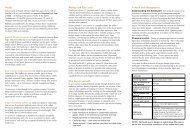Bushland Weeds Manual - Environmental Weeds Action Network
Bushland Weeds Manual - Environmental Weeds Action Network
Bushland Weeds Manual - Environmental Weeds Action Network
Create successful ePaper yourself
Turn your PDF publications into a flip-book with our unique Google optimized e-Paper software.
40<br />
Chapter 4 Corms, Bulbs and Tubers<br />
Timing is everything<br />
Understanding the life-cycle of the weedy geophytes<br />
over the growing season can mean the difference<br />
between effective control and unwitting spread. For<br />
many species hand-removal should only be carried out<br />
early in the growing season.<br />
• Late in the growing season specialised roots<br />
(known as contractile roots) drag annually<br />
renewed corms or bulbs deeper down into the soil.<br />
For the relevant species hand-removal is much<br />
easier and causes a lot less soil disturbance if<br />
undertaken early in the growing season e.g.<br />
Freesia, Sparaxis and Watsonia.<br />
• Stem cormels and bulbils are produced towards<br />
the end of the growing season. These are easily<br />
dislodged and can contribute to the spread of the<br />
weed you are trying to control e.g. Freesia,<br />
Sparaxis bulbifera, Lachenalia bulbifera.<br />
• Oxalis species produce bulbils at the nodes of<br />
underground stems later in the season, just after<br />
flowering. These are easily dislodged and handremoval,<br />
after bulbil formation has occurred,<br />
will generally contribute to their spread e.g.<br />
Soursob, Finger Leaf Oxalis and Four O’Clock.<br />
• Towards the end of the growing season, as the<br />
days get longer and warmer, many species finish<br />
flowering and start producing seed (often<br />
coincides with bulbil and cormel production).<br />
When physically removing plants that are setting<br />
seed ensure seed is not dislodged and spread<br />
through the bushland as material is transported.<br />
For the following species physical removal is<br />
hazardous at any time.<br />
• Those species that produce masses of cormels<br />
around the base are extremely difficult to<br />
physically remove without dislodging and<br />
spreading cormels any time of the year. The<br />
cormels are tiny, float in water and easily stick<br />
with mud to boots, tools and the feet of animals.<br />
Physical removal needs to be undertaken<br />
in a way that avoids releasing or dropping<br />
cormels. e.g. Wavy Gladiolus, Long Tubed<br />
Painted Lady (Gladiolus angustus) and<br />
Two Leaf Cape Tulip. The parent<br />
corm often confers dormancy on<br />
cormels and its removal is often<br />
followed by mass germination<br />
of those cormels left behind.<br />
• Arum Lily produces numerous tiny daughter<br />
tubers that become dislodged during handremoval.<br />
This appears to happen throughout the<br />
growing season.<br />
• The rhizomes attached to the tubers of Bridal<br />
Creeper will produce new shoots from any tiny<br />
fragments left behind.<br />
Note: Physical removal of weeds such as Watsonia, Arum Lily or<br />
Bridal Creeper on steeper slopes or along creeks and riverbanks can<br />
lead to serious soil erosion.<br />
fruits containing<br />
seed<br />
stem cormels<br />
a b c d<br />
Harlequin flower (Sparaxis bulbifera); a) Summer, dormant corm b) Late autumn, corm begins to sprout c) Early spring, flowering and corm<br />
exhaustion d) Spring to early summer, leaves begin to die back, seed and stem cormels are formed.



